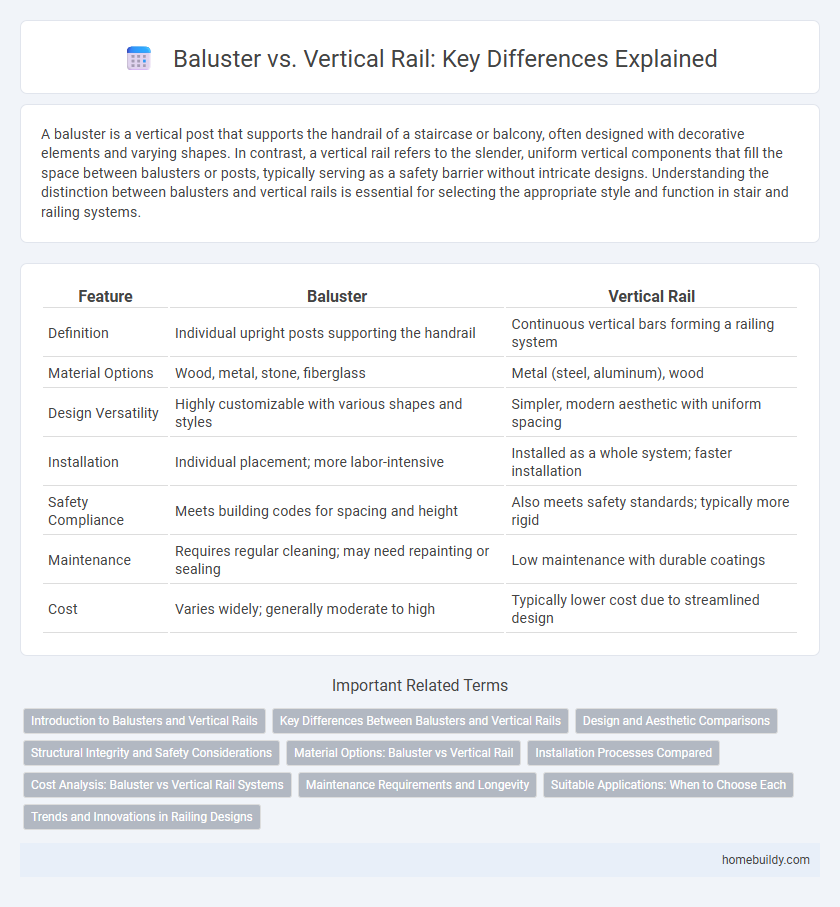A baluster is a vertical post that supports the handrail of a staircase or balcony, often designed with decorative elements and varying shapes. In contrast, a vertical rail refers to the slender, uniform vertical components that fill the space between balusters or posts, typically serving as a safety barrier without intricate designs. Understanding the distinction between balusters and vertical rails is essential for selecting the appropriate style and function in stair and railing systems.
Table of Comparison
| Feature | Baluster | Vertical Rail |
|---|---|---|
| Definition | Individual upright posts supporting the handrail | Continuous vertical bars forming a railing system |
| Material Options | Wood, metal, stone, fiberglass | Metal (steel, aluminum), wood |
| Design Versatility | Highly customizable with various shapes and styles | Simpler, modern aesthetic with uniform spacing |
| Installation | Individual placement; more labor-intensive | Installed as a whole system; faster installation |
| Safety Compliance | Meets building codes for spacing and height | Also meets safety standards; typically more rigid |
| Maintenance | Requires regular cleaning; may need repainting or sealing | Low maintenance with durable coatings |
| Cost | Varies widely; generally moderate to high | Typically lower cost due to streamlined design |
Introduction to Balusters and Vertical Rails
Balusters are vertical posts that provide support and aesthetic appeal to stair railings and balconies, often shaped and designed for decorative purposes. Vertical rails serve as structural members placed between handrails and base rails, offering stability and safety by preventing falls without necessarily having intricate designs. Understanding the distinction between balusters and vertical rails is essential for selecting the right components in stair construction and architectural detailing.
Key Differences Between Balusters and Vertical Rails
Balusters are individual, decorative posts used to support a handrail and are typically spaced evenly along staircases or balconies, providing structural support and aesthetic appeal. Vertical rails, also known as pickets or spindles, are the vertical components that connect the bottom rail to the handrail, often simpler in design and primarily focused on safety and code compliance. Key differences between balusters and vertical rails include their design complexity, function in supporting the handrail versus filling gaps for safety, and their typical placement within stair or railing assemblies.
Design and Aesthetic Comparisons
Balusters offer intricate craftsmanship and varied shapes, contributing to a classic and ornate design that enhances the architectural detail of staircases and railings. Vertical rails provide a minimalist and modern look, featuring clean lines that emphasize simplicity and openness in contemporary spaces. The choice between balusters and vertical rails significantly impacts the aesthetic ambiance, balancing traditional charm with sleek modernity.
Structural Integrity and Safety Considerations
Balusters provide enhanced structural integrity compared to vertical rails by offering greater load distribution and resistance to lateral forces, reducing the risk of railing failure. Their robust design ensures improved safety by minimizing gaps that could pose hazards, especially for children and pets. Vertical rails, while aesthetically simple, often lack the same strength and secure attachment points, making them less reliable in high-stress applications.
Material Options: Baluster vs Vertical Rail
Balusters are commonly crafted from materials such as wood, wrought iron, aluminum, and glass, offering a wide range of aesthetic and durability options. Vertical rails often utilize metal or composite materials, providing enhanced structural support and resistance to weather conditions. Choosing between balusters and vertical rails depends on the desired balance of style, maintenance, and strength requirements for the railing system.
Installation Processes Compared
Baluster installation involves individual placement and securing each spindle to the stair tread and handrail, requiring precise measurements and alignment for safety and aesthetics. Vertical rail systems use prefabricated panels that simplify installation by attaching entire sections at once, reducing labor time and ensuring uniform spacing. While balusters offer customization in design and spacing, vertical rails provide a faster, more consistent installation process suitable for modern construction.
Cost Analysis: Baluster vs Vertical Rail Systems
Baluster systems typically incur higher installation and material costs compared to vertical rail systems due to their intricate designs and use of premium materials like wrought iron or wood. Vertical rail systems often offer a more cost-effective solution, leveraging simpler manufacturing processes and materials such as aluminum or vinyl, which reduce overall expenses. When selecting between baluster and vertical rail systems, homeowners should weigh the initial investment against long-term maintenance costs and aesthetic preferences to determine the best value for their project.
Maintenance Requirements and Longevity
Balusters typically require less maintenance than vertical rails due to their solid construction and resistance to warping, especially when made from durable materials like wrought iron or hardwood. Vertical rails, often composed of multiple slender components, can be more prone to damage and require frequent inspections, cleaning, and repairs to prevent structural weakening. The longevity of balusters surpasses that of vertical rails in harsh environments, as their robust design minimizes wear and prolongs the overall lifespan of railing systems.
Suitable Applications: When to Choose Each
Balusters are ideal for staircases and balconies requiring decorative, individual supports that enhance architectural aesthetics, while vertical rails are best suited for safety-critical areas needing continuous support and simpler installation. Balusters excel in traditional and ornate designs where visual appeal is a priority, whereas vertical rails provide a modern, minimalistic look perfect for commercial and high-traffic environments. Choosing balusters suits residential projects emphasizing style, while vertical rails are preferred for enhanced durability and compliance with strict building codes.
Trends and Innovations in Railing Designs
Balusters are increasingly favored over vertical rails due to their ability to blend traditional craftsmanship with modern aesthetics, offering customizable shapes and materials such as wrought iron, wood, and composite. Innovations in baluster design include laser-cut patterns and integrated lighting, enhancing both safety and visual appeal in contemporary railing systems. Current trends emphasize eco-friendly materials and minimalist profiles, aligning baluster use with sustainable architecture and sleek interior design concepts.
Baluster vs Vertical Rail Infographic

 homebuildy.com
homebuildy.com